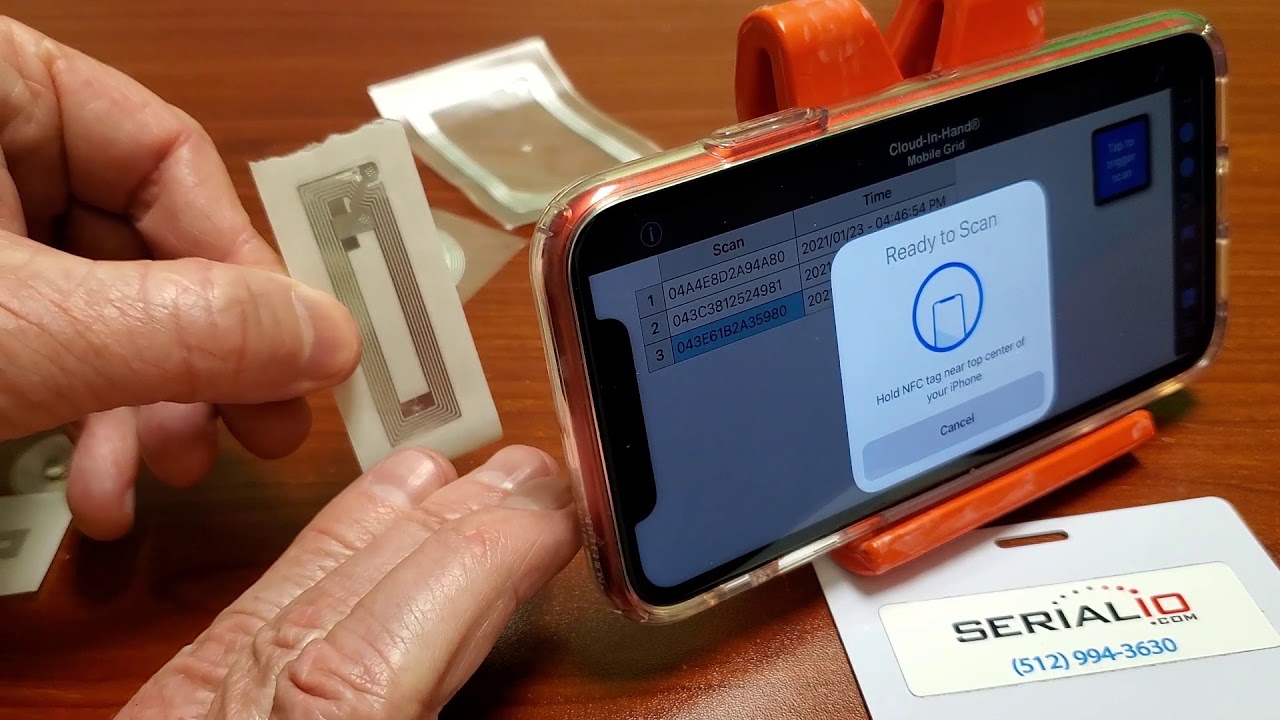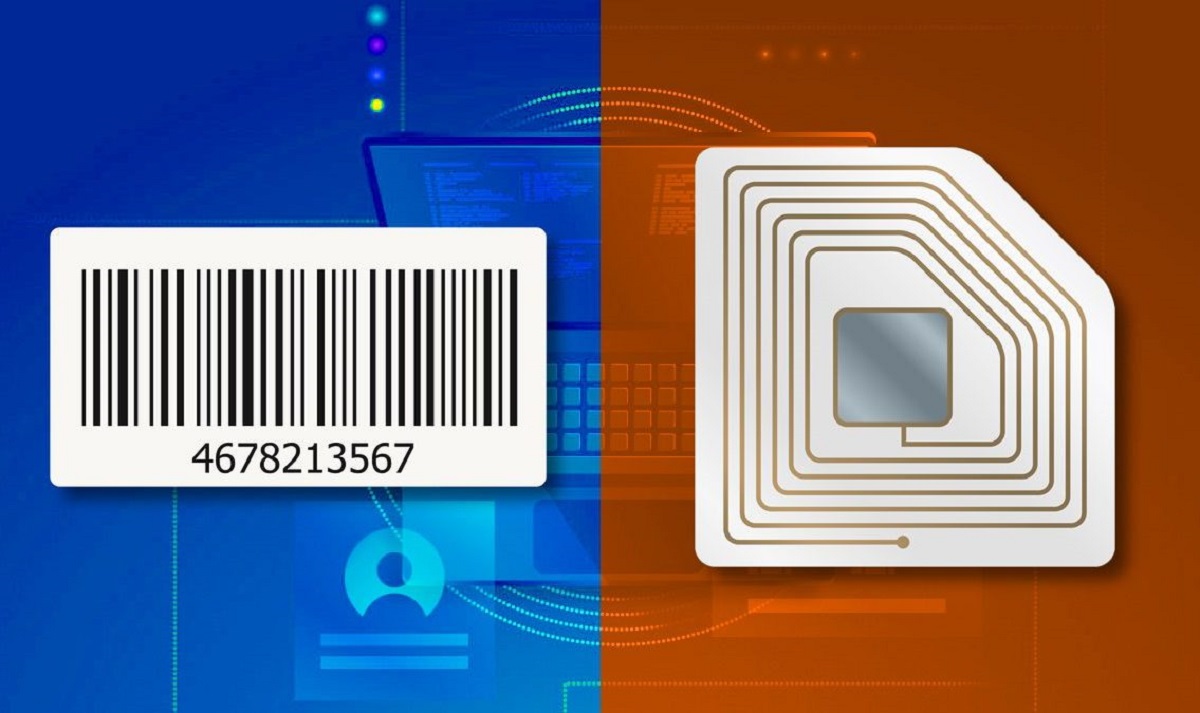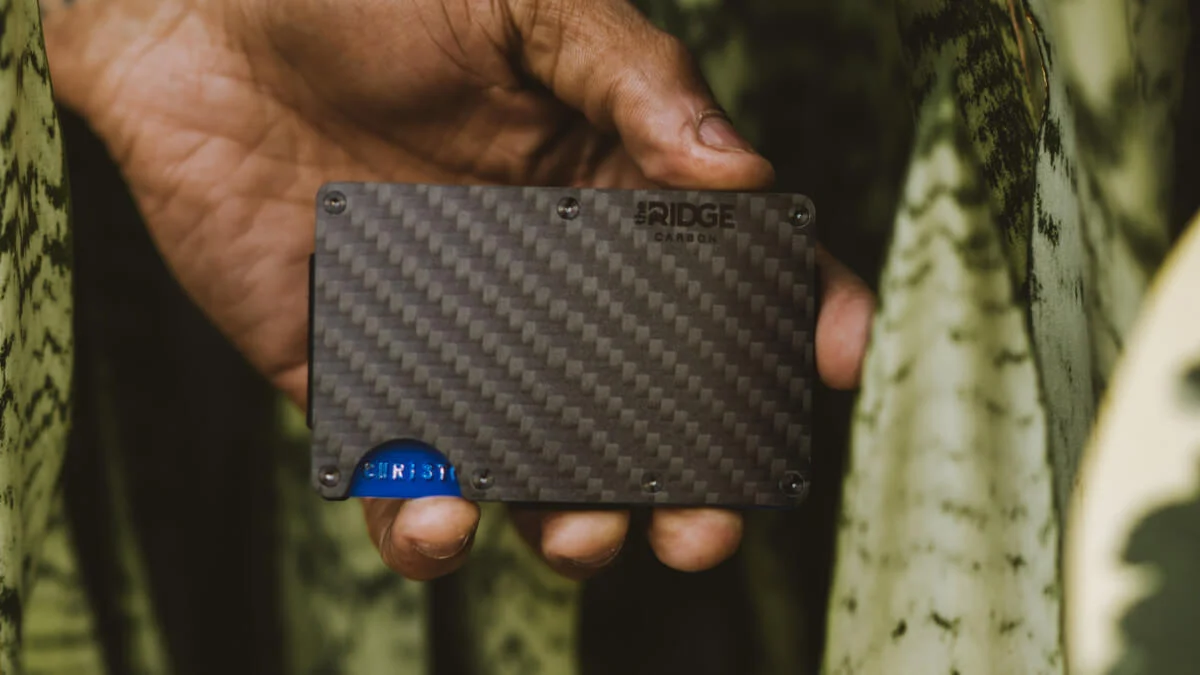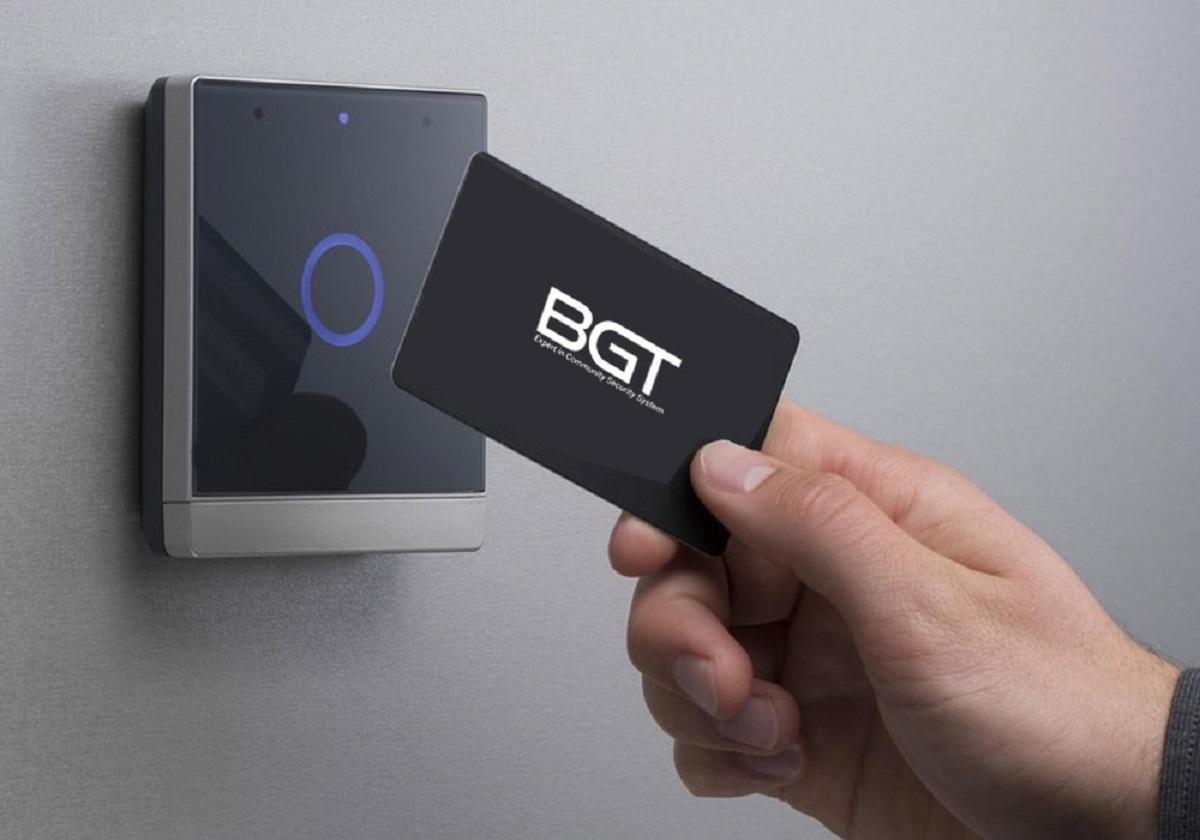Introduction
Welcome to our guide on how to scan RFID tags. RFID, which stands for Radio Frequency Identification, is a technology that has revolutionized the way items are tracked and identified. RFID tags are small devices that contain a unique identifier and can communicate wirelessly with RFID readers. The applications of RFID technology are vast, ranging from inventory management in retail stores to tracking assets in logistics and supply chain operations.
So, why is it important to know how to scan RFID tags? Well, as RFID technology becomes increasingly prevalent in various industries, being able to effectively scan and read RFID tags is crucial for accurate and efficient data collection. Whether you’re a business owner, a warehouse manager, or simply curious about this technology, learning how to properly scan RFID tags will give you valuable insights into their operation and potential uses.
In this guide, we will walk you through the fundamentals of RFID technology, including how RFID tags work and the different types available. We will also provide you with a step-by-step guide on how to scan RFID tags successfully, along with tips for ensuring accurate readings. Additionally, we will address common challenges that may arise during the scanning process and offer troubleshooting advice.
By the end of this guide, you will have a comprehensive understanding of how to scan RFID tags and will be equipped with the knowledge to harness the power of this technology in your personal or professional endeavors. So, let’s dive in and explore the world of RFID scanning!
What is RFID Technology
RFID, which stands for Radio Frequency Identification, is a technology that allows the identification and tracking of objects using radio waves. It consists of two main components: RFID tags and RFID readers. RFID tags are small devices that contain a unique identifier and can transmit data wirelessly. These tags can be attached to objects or embedded in products, enabling them to be easily identified and tracked.
The RFID system operates on the principle of electromagnetic fields. When an RFID reader emits radio waves, the RFID tag within its range is powered by the electromagnetic field and responds by transmitting its unique identification information back to the reader. This interaction between the reader and the tag occurs without direct line-of-sight contact, making RFID technology more convenient and efficient than traditional barcode scanning.
RFID technology offers numerous advantages over other tracking methods. First and foremost, it allows for quick and accurate data collection. With the ability to scan multiple tags simultaneously, RFID technology significantly reduces the time and effort required for inventory management and asset tracking. Additionally, RFID tags can be read from a distance, making it possible to track items without physical intervention.
Another key benefit of RFID technology lies in its versatility. RFID tags come in various forms and sizes, making them suitable for a wide range of applications. From small adhesive tags used in retail stores to ruggedized tags for industrial environments, there is an RFID solution for every need. Moreover, RFID technology can be integrated with other systems, such as Enterprise Resource Planning (ERP) software, to provide real-time data and improve operational efficiency.
Overall, RFID technology has revolutionized the process of identification and tracking. It has found applications in various industries, including retail, healthcare, transportation, and logistics. With its ability to streamline operations, increase accuracy, and enhance security, RFID technology is transforming the way businesses manage their assets and inventory.
How do RFID tags work?
RFID tags consist of a microchip, an antenna, and a substrate. The microchip contains the unique identification data of the tag, while the antenna enables communication with the RFID reader via radio waves. The substrate provides support and protection for the microchip and antenna.
When an RFID reader emits radio waves, it creates an electromagnetic field. The RFID tag within the range of this field absorbs some of the energy from the field and uses it to power up the microchip. Once powered, the microchip activates and transmits the identification data stored within it back to the reader via the antenna.
There are two main types of RFID tags: passive and active. Passive RFID tags do not have an internal power source and rely on the energy provided by the RFID reader to power up. These tags are typically smaller and less expensive than active tags, but they have a shorter communication range.
Active RFID tags, on the other hand, have their own power source, usually a battery. This allows them to transmit data over longer distances and provides them with more functionality. Active tags can be read from several meters away and can even include additional sensors for capturing environmental data.
RFID tags use different frequencies for communication, depending on the application and regulations in the specific region. Common frequency bands for RFID tags include Low Frequency (LF), High Frequency (HF), and Ultra High Frequency (UHF). Each frequency band has its own advantages and limitations in terms of range, interference, and data transfer speed.
When an RFID tag is within range of an RFID reader, the reader captures the transmitted data and processes it. The data can then be used for various purposes, such as inventory management, authentication, access control, and tracking.
Overall, RFID tags work by utilizing radio frequency technology to enable data transfer between the tag and the reader. This seamless and wireless communication allows for efficient and accurate identification and tracking of objects in a wide range of industries.
Types of RFID tags
RFID tags come in different forms, each designed to suit specific applications and environments. The type of RFID tag chosen depends on factors such as the required read range, the type of material it will be attached to, and the environmental conditions it will be exposed to. Here are some common types of RFID tags:
- Passive RFID Tags: Passive RFID tags do not have their own power source and rely on the energy transmitted by the RFID reader to operate. These tags are cost-effective and widely used in applications such as inventory management, supply chain tracking, and access control. They have a shorter read range compared to active tags but are ideal for applications where close proximity scanning is sufficient.
- Active RFID Tags: Active RFID tags have their own power source, typically a battery, which allows them to transmit data over longer distances. These tags have a greater read range and are commonly used in applications that require the tracking of high-value assets, real-time location systems (RTLS), and vehicle tracking. Active tags can be larger and more expensive than passive tags, but they offer enhanced functionality and flexibility.
- UHF RFID Tags: Ultra High Frequency (UHF) RFID tags operate in the frequency range of 860-960 MHz. They are known for their long read range and high data transfer speed. UHF tags are commonly used in retail, logistics, and supply chain management due to their ability to quickly scan multiple items simultaneously.
- HF RFID Tags: High Frequency (HF) RFID tags operate in the frequency range of 13.56 MHz. These tags are widely used in applications such as access control, ticketing systems, and electronic payments. HF tags offer a moderate read range and are suitable for applications that require close proximity scanning.
- LF RFID Tags: Low Frequency (LF) RFID tags operate in the frequency range of 125-134 kHz. These tags are commonly used in applications where close proximity scanning is required, such as animal and pet identification, access control, and keyless entry systems.
In addition to these types, RFID tags can also vary in terms of form factor and attachment method. Some tags are designed to be adhered to surfaces using adhesive backing, while others can be embedded in products or attached using screws or ties. The choice of tag type and attachment method depends on the specific application requirements.
Understanding the different types of RFID tags available allows businesses to choose the most suitable option for their needs, whether it’s for inventory management, asset tracking, or other tracking and identification purposes.
Tools needed for scanning RFID tags
Scanning RFID tags requires a few essential tools to ensure accurate readings and efficient data collection. The tools needed may vary depending on the specific RFID system and application. Here are some common tools used for scanning RFID tags:
- RFID Reader: An RFID reader is a device that emits radio waves to communicate with RFID tags. It reads the unique identification data stored in the tags and captures this information for further processing. RFID readers can be handheld devices or fixed installations depending on the application. They come in a variety of form factors and support different RFID frequencies.
- RFID Tags: Of course, you will also need RFID tags to scan. The type of RFID tags you need will depend on your specific application requirements and environment. Ensure that the tags you select are compatible with your RFID reader in terms of frequency and standards.
- Antennas: The antenna is a crucial component of an RFID system as it enables communication between the RFID reader and the tags. The selection of the antenna will depend on factors such as the desired read range, tag orientation, and environmental conditions. Different types of antennas are available, including linear polarized, circular polarized, and patch antennas.
- Power Source: Depending on the specific RFID system, you may need a power source to operate the RFID reader and the accompanying equipment. Ensure that you have access to a power supply or battery source to power the devices during scanning.
- Software or Middleware: In many cases, RFID scanning requires software or middleware to process and manage the collected data. This software allows you to configure the reader settings, customize read events, and integrate the RFID data into existing systems or applications.
- Connection Cables: To connect the RFID reader to a computer or other devices, you will likely need connection cables. These cables facilitate data transfer and communication between the reader and external systems.
- Testing and Calibration Tools: It can be helpful to have testing and calibration tools to ensure that your RFID system is working optimally. These tools enable you to verify read range, check for interference, and fine-tune the system’s performance.
It’s important to consider the specific requirements of your RFID application when selecting and acquiring the necessary tools. Ensuring compatibility and reliability between the reader, tags, antennas, and other components will contribute to the success of your RFID scanning activities.
Step-by-step guide on how to scan RFID tags:
Scanning RFID tags involves a systematic process to ensure accurate readings and efficient data collection. Follow these step-by-step instructions to successfully scan RFID tags:
- Set up the RFID reader: Begin by setting up the RFID reader according to the manufacturer’s instructions. This may involve connecting the reader to a power source and a computer or other devices if necessary. Make sure the reader is properly installed and ready for operation.
- Prepare the scanning environment: Clear any obstructions or clutter in the scanning environment to ensure smooth operations. Remove unnecessary objects or materials that could interfere with the RFID signals. Ensure that the area has sufficient lighting for accurate tag scanning.
- Power on the RFID reader: Ensure that the RFID reader is powered on and connected to the appropriate power source. The reader should be displaying the necessary indicators to indicate that it is ready for scanning.
- Position the RFID tags correctly: Place the RFID tags in the desired location, ensuring that they are within the range of the RFID reader’s signal. Proper tag placement is essential for accurate scanning. Avoid placing tags too close together or overlapping, as this could result in interference.
- Activate the scanning process: Activate the scanning process by initiating a read command on the RFID reader. This can usually be done by pressing a button or triggering a command in the accompanying software. The reader will emit radio waves to communicate with the nearby RFID tags and capture their unique identification data.
- Interpret the scan results: Once the scanning process is complete, review the scan results displayed on the RFID reader or in the associated software. Verify that the scanned tags appear correctly and that the data collected is accurate. Take note of any discrepancies or errors that may require further investigation.
By following these steps, you will be able to scan RFID tags effectively and efficiently. Remember to adjust the scanning process and settings as needed based on the specific requirements of your RFID system and application.
Set up the RFID reader
Properly setting up the RFID reader is the first crucial step in scanning RFID tags. Follow these guidelines to ensure a successful setup:
a. Read the manufacturer’s instructions: Start by carefully reading the instructions and user manual provided by the RFID reader manufacturer. This will give you a clear understanding of the setup process and any specific requirements or recommendations for your particular device.
b. Gather the necessary components: Ensure that you have all the necessary components for the RFID reader setup. This typically includes the reader itself, power adapters or batteries, connection cables, and any additional accessories required for your specific application.
c. Choose an appropriate location: Select a suitable location for your RFID reader. Consider factors such as signal strength, interference, and accessibility. Ideally, the reader should be positioned in an area with minimal obstructions and a clear line of sight to the RFID tags you will be scanning.
d. Connect the power source: Depending on the type of RFID reader, connect it to a power source such as an electrical outlet or battery. Follow the instructions provided to ensure proper connection and compatibility. Make sure that the power source is reliable and can provide sufficient power to the reader for uninterrupted scanning.
e. Connect to external devices: If your RFID reader requires connection to external devices such as a computer, POS system, or network, use the appropriate connection cables to establish the necessary connections. Ensure that the cables are securely plugged in and that the connections are stable.
f. Install any required software: Some RFID readers may require software installation for configuration and data management. If this is the case, install the provided software on the required devices, following the installation instructions provided. Ensure that the software is compatible with your operating system and that any necessary drivers are installed correctly.
g. Perform a test run: After setting up the RFID reader, perform a test run to ensure that it is functioning properly. Check for power supply stability, connectivity to external devices, and any indicators or error messages displayed on the reader or software interface. Test the reader’s functionality by scanning a few RFID tags to verify that data is being accurately captured.
By carefully following these steps, you will set up your RFID reader correctly, laying the foundation for successful RFID tag scanning. Taking the time to properly set up the reader ensures the reliability and accuracy of the scanning process, allowing you to capture the data you need for your specific application.
Prepare the scanning environment
Preparing the scanning environment is an important step in ensuring optimal conditions for scanning RFID tags. Follow these guidelines to create a suitable environment for accurate and efficient tag scanning:
a. Clear the area: Remove any unnecessary clutter or objects from the scanning area. Ensure that there are no obstructions that could interfere with the RFID signals. Clearing the area will allow for unimpeded communication between the RFID reader and tags, reducing the chances of inaccurate readings or signal interference.
b. Minimize metal and reflective surfaces: Metal objects and reflective surfaces can reflect or absorb RFID signals, leading to signal distortion or weakening. Minimize the presence of metal objects and reflective surfaces in the scanning environment to optimize the signal strength and improve scanning accuracy.
c. Ensure adequate lighting: Proper lighting is essential for accurately scanning RFID tags. Make sure the scanning area is well-lit, as poor lighting can hinder the readability of tags and affect scanning accuracy. Avoid areas with excessive glare or shadowing that could obscure the tags or interfere with the reader’s ability to detect them.
d. Consider tag orientation: Take into account the optimal tag orientation for scanning. Ensure that the RFID tags are positioned in a way that allows the reader’s signal to be effectively transmitted and received. Experiment with different tag orientations and angles to find the optimal position that yields the best scanning results.
e. Eliminate electromagnetic interference: Minimize sources of electromagnetic interference in the scanning environment. Electrical devices, power lines, and other sources of electromagnetic radiation can disrupt the RFID signals and affect scanning performance. Keep the scanning area away from such sources to avoid interference and ensure accurate tag scanning.
f. Conduct a test scan: Before proceeding with actual scanning, perform a test scan to verify environmental conditions. Scan a few RFID tags in the designated environment and check the scanning results. If there are any issues with readability or accuracy, adjust the environment accordingly to improve scanning performance.
g. Document the environment: Keep a record of the scanning environment, noting any specific details or conditions that may impact scanning. This documentation will be useful for troubleshooting and future reference, allowing you to identify any environmental factors that may affect the scanning process.
By following these steps, you will create an optimal scanning environment for RFID tags. A well-prepared environment will contribute to accurate and efficient scanning, ensuring that you are able to capture the necessary data from your RFID tags seamlessly.
Power on the RFID reader
Powering on the RFID reader is a critical step in the scanning process. Follow these guidelines to ensure a smooth and successful startup of the RFID reader:
a. Verify the power source: Before powering on the RFID reader, ensure that the power source is compatible and provides the appropriate voltage for the device. Check the manufacturer’s instructions or specifications to confirm the required power input for the reader. Connect the reader to the power source accordingly.
b. Connect any necessary cables: If the RFID reader requires connection to external devices or a network, make sure to connect the appropriate cables securely. This may include USB, Ethernet, or serial cables, depending on the connectivity options provided by the reader. Double-check that all connections are properly inserted and tightened.
c. Press the power button: Locate the power button or switch on the RFID reader and press or slide it to turn on the device. Some readers may have a separate power adapter that needs to be switched on. Refer to the user manual or instructions provided by the manufacturer for specific details on how to power on the reader.
d. Observe the power indicators: After powering on the RFID reader, observe the power indicators on the device. These indicators can provide valuable information about the reader’s status, such as whether it has successfully powered on or if there are any errors or issues. Different readers may have different indicator lights, so consult the user manual to understand their meanings.
e. Allow the reader to initialize: After powering on the RFID reader, allow it a few moments to initialize and boot up. During this time, the reader sets up its internal components and establishes a connection with any connected devices or networks. Avoid any interactions or operations until the reader has completed its initialization process.
f. Perform a power-on self-test: Many RFID readers perform a self-test upon powering on to ensure that all components are functioning properly. This may include checking the antenna, signal strength, and connectivity. Monitor the reader’s display or check the software interface for any self-test results or error messages. Take note of any issues that require further attention or troubleshooting.
By following these steps, you will power on the RFID reader correctly and ensure that the device is ready for scanning RFID tags. Proper power-on procedures contribute to the overall reliability and performance of the reader, creating a solid foundation for successful tag scanning activities.
Position the RFID tags correctly
Positioning the RFID tags correctly is crucial for successful scanning and accurate data collection. Follow these guidelines to ensure that you properly position the RFID tags:
a. Determine the optimal tag placement: Consider the application and the specific requirements for tag placement. Depending on the purpose of your RFID system, you may need to adhere the tags to surfaces, attach them to objects, or embed them within products. Identify the most suitable location for the tags to ensure optimal scanning performance.
b. Maintain an appropriate tag-to-reader distance: Ensure that the RFID tags are within the effective range of the RFID reader. Consult the specifications provided by the manufacturer to determine the optimal distance for scanning. Avoid placing the tags too close together or too far away from the reader, as this may impact readability or result in signal interference.
c. Avoid metal or dense materials: Take into account the materials surrounding the RFID tags. Metal objects and dense materials can interfere with the radio waves transmitted by the reader, potentially affecting the scanning accuracy. Minimize the presence of metallic or dense objects in close proximity to the tags to optimize scanning performance.
d. Consider tag orientation: Position the RFID tags in a way that allows for optimal tag orientation for scanning. Orientation can impact the readability of tags, depending on the reader’s antenna design. Experiment with different orientations to find the one that yields the best scanning results. In some cases, it may be necessary to tilt or adjust the tags to achieve the desired read rates.
e. Ensure tag visibility: Make sure that the RFID tags are positioned in a way that allows the reader to have a clear line of sight to them. Avoid obstructing the tags with other objects or placing them in areas where they may be hidden from the reader’s view. Promote visibility to maximize successful tag scanning.
f. Account for tag size and shape: Different RFID tags come in various shapes and sizes. Consider the dimensions of the tags when positioning them. Ensure that the tags are secured and aligned properly according to their specific form factor. Some tags may require specific attachment methods, such as threading, adhesive backing, or embedding, so follow the manufacturer’s guidelines accordingly.
g. Test the tag positioning: Perform test scans with different tag positions and orientations to verify readability. Observe the scanning results and make any necessary adjustments or fine-tuning to the tag positioning. Optimize the system to achieve the highest possible read rates and accuracy.
By following these steps, you will position the RFID tags correctly, ensuring optimal scanning performance and accurate data collection. Proper tag positioning greatly contributes to the effectiveness and efficiency of RFID scanning activities.
Activate the scanning process
Activating the scanning process is a crucial step in capturing data from RFID tags. Follow these guidelines to effectively activate the scanning process:
a. Trigger the scanning command: Depending on the RFID reader model and associated software, you may need to initiate the scanning process by triggering a command. This can typically be done through the reader’s control panel or by using the software interface. Consult the user manual or instructions provided to understand how to activate the scanning command.
b. Ensure the reader is within range: Verify that the RFID reader is within the effective range of the RFID tags you want to scan. Maintain an optimal distance between the reader and tags to ensure reliable communication. If the tags are too far or too close to the reader, it may result in weaker signal strength or interference, leading to incomplete or inaccurate scanning.
c. Monitor the scanning status: Observe the scanning status indicators on the RFID reader or in the associated software interface. Keep an eye on any notifications or progress updates during the scanning process. This will provide real-time feedback on the scanning operation and help identify any issues that may arise.
d. Allow sufficient time for scanning: Depending on the number of tags being scanned and the reading speed of the RFID reader, allow sufficient time for the reader to capture the data from the tags. Avoid interrupting the scanning process prematurely. Wait until the reader has completed the scan for all relevant tags before proceeding to the next step.
e. Maintain steady positioning: While the RFID reader is scanning the tags, maintain a steady position for both the reader and the tags. Any movements or instability can lead to inconsistencies in signal strength and may result in partial or failed scans. Keep the reader and tags stationary until the scanning process is completed.
f. Verify the scan results: After the scanning process is finished, verify the scan results captured by the RFID reader. Check that the scanned tags appear correctly and that the associated data is accurate. Compare the scanned data with the expected information to ensure successful scanning and reliable data collection.
g. Repeat the scanning if necessary: If any tags were not successfully scanned or if the scan results are incomplete or inconsistent, consider repeating the scanning process. Adjust the positioning, orientation, or settings as needed to improve the scanning performance. Repeat the scanning until all tags are successfully captured and the data is accurately recorded.
By following these steps, you will effectively activate the scanning process, ensuring that RFID tags are accurately read and the associated data is collected. Proper activation of the scanning process guarantees reliable and efficient RFID data capture for your specific application needs.
Interpret the scan results
Interpreting the scan results is a crucial step in the RFID tag scanning process. Follow these guidelines to effectively interpret the scan results:
a. Review the captured data: Examine the scanned data retrieved from the RFID reader. Verify that the unique identification information from the tags is accurately captured. Pay attention to any additional data or metadata associated with the tags, such as timestamps or sensor readings, if applicable to your specific RFID system.
b. Confirm data integrity: Ensure that the scanned data is free from errors or inconsistencies. Check for any missing or duplicate entries. If certain tags were not detected or if there are any anomalies in the data, investigate and troubleshoot the potential causes. Data integrity is crucial for making informed decisions and taking appropriate actions based on the scanned information.
c. Analyze and process the data: Depending on your application, analyze and process the scanned data for further utilization. This may involve storing the data in a database, integrating it into existing systems, or performing data analytics. Apply any necessary transformations or validations to ensure the accuracy and quality of the data for subsequent operations.
d. Extract actionable insights: Extract meaningful insights from the scanned data to derive value from the RFID scanning process. Identify patterns, trends, or anomalies that can inform decision-making, improve operational efficiency, or uncover opportunities for optimization. Generate reports or visualizations that convey the insights clearly to stakeholders or other relevant parties.
e. Address any discrepancies or errors: If you encounter any discrepancies or errors in the scan results, investigate the root cause. Verify the tag positioning, orientation, or environmental factors that could impact the scanning process. Consider re-scanning the affected tags or adjusting the scanning setup to rectify any issues and ensure accurate data collection.
f. Maintain data traceability: Maintain a record of the scanned data and associated metadata. This will provide a historical trail for auditing purposes and enable traceability in case of any data-related issues or inquiries. Implement appropriate data management practices to securely store and protect the collected RFID data.
g. Continuously improve scanning accuracy: Regularly evaluate and improve the scanning process to enhance accuracy and efficiency. Incorporate feedback from the scan results and user experiences to refine the tag positioning, scanning settings, or environmental conditions. By continuously seeking improvements, you can optimize the scanning process over time.
By following these steps, you will effectively interpret the scan results obtained from the RFID scanning process. Proper interpretation of the data ensures the reliability and usefulness of the captured information for making informed decisions and driving efficiency in your RFID system.
Tips for successful RFID tag scanning
Scanning RFID tags successfully requires attention to detail and effective implementation of best practices. Here are some valuable tips to ensure successful RFID tag scanning:
a. Optimize tag-reader positioning: Experiment with different tag and reader positions to find the optimal alignment for reliable scanning. Consider factors such as tag orientation, distance, and signal strength to achieve the best read rates.
b. Maintain consistent tag placement: Ensure consistent and accurate tag placement across all items or assets. This helps minimize variability in the scanning process and optimizes the consistency and reliability of the data collected.
c. Avoid tag-to-tag interference: Prevent RFID tags from being too close to each other, as this can lead to signal interference. Maintain an adequate distance between adjacent tags to prevent cross-communication and to ensure accurate reading of individual tags.
d. Regularly calibrate and test the system: Periodically calibrate the RFID reader and test the overall system to ensure optimal performance. This includes checking antenna alignment, verifying signal strength, and conducting range tests to identify and rectify any potential issues.
e. Minimize environmental interference: Reduce potential sources of interference such as electromagnetic fields, metal objects, or reflective surfaces in the scanning environment. These factors can negatively impact signal quality and readability, so mitigate their effects to optimize scanning accuracy.
f. Periodically clean and maintain tags: Clean RFID tags to remove dirt, debris, or any substances that may hinder readability. Maintain the tags in good condition by adhering to the manufacturer’s guidelines, replacing worn-out tags when necessary, and ensuring proper attachment to the items.
g. Conduct regular tag audits: Regularly audit the RFID tag population to ensure all items have a functioning tag and that the information associated with each tag is accurate and up to date. This helps minimize inconsistencies and inaccuracies during the scanning process.
h. Train users and provide clear instructions: Provide comprehensive training to users responsible for scanning RFID tags. Educate them on proper scanning techniques, tag placement, environmental considerations, and troubleshooting procedures. Clear instructions and guidelines will help maintain consistency and accuracy across the scanning process.
i. Monitor scanning performance and analyze data: Continuously monitor scanning performance and track key performance indicators such as read rates, read distances, or data accuracy. Regularly analyze the collected data to identify trends, patterns, or anomalies in scanning results. This information can lead to process improvements and optimization strategies.
j. Stay updated with RFID technology: Stay informed about advancements in RFID technology, including new tag designs, improved reader capabilities, and emerging standards. This will help you leverage the latest developments and ensure you are using the most efficient and effective RFID solution for your specific needs.
By implementing these tips, you can enhance the success of RFID tag scanning, improve data quality, and maximize the value of your RFID system for accurate identification, tracking, and inventory management.
Common challenges and troubleshooting
While RFID technology offers numerous benefits, certain challenges may arise during the tag scanning process. Understanding these challenges and implementing effective troubleshooting strategies can help overcome them. Here are some common challenges and their corresponding troubleshooting suggestions:
a. Poor RFID tag readability: If tags are consistently unreadable, check the tag placement and orientation. Ensure that tags are positioned correctly, and adjust their orientation if necessary. Also, verify the tag-reader distance and adjust it to optimize signal strength. In some cases, it may be necessary to replace faulty or worn-out tags that have become unreadable.
b. Interference from nearby objects: Metal objects, dense materials, or reflective surfaces can interfere with RFID signals. Minimize their presence in the scanning environment or reposition tags to avoid proximity to such objects. Additionally, adjust the reader’s power and sensitivity settings as needed to mitigate interference.
c. Inconsistent read rates: Inconsistent read rates can occur due to environmental factors, tag quality, or reader settings. Conduct range tests to identify dead spots or areas with weak signals. Ensure that the reader’s antenna is aligned correctly and adjust its position or orientation if required. If read rates remain inconsistent, consider calibrating the reader or upgrading to a more sophisticated reader model.
d. Difficulty scanning dense tag populations: When scanning a large number of tags within close proximity, tag-to-tag interference can occur. Increase the tag-reader distance or adjust the scanning speed to allow for more effective communication between the reader and individual tags. Alternatively, consider using anti-collision techniques or advanced reader models that can handle dense tag populations more efficiently.
e. Environmental factors affecting signal quality: Environmental conditions such as humidity, temperature, or electromagnetic fields can impact signal quality. Monitor and control these factors to minimize their effects. Use ruggedized tags designed for harsh environments, and ensure that readers are appropriately shielded from external electromagnetic sources.
f. Data collection errors: Data collection errors can arise due to inconsistent tag placement, tag misreads, or software glitches. Regularly audit the tag population to ensure data accuracy and resolve any inconsistencies. Validate and format the collected data to ensure the correct interpretation and analysis of the scanned information.
g. Reader or software compatibility issues: Incompatibilities between the reader and software can lead to communication issues or data extraction problems. Ensure that the reader and software are compatible and running the latest firmware or software versions. If compatibility issues persist, reach out to the manufacturer’s technical support or consider using alternative reader or software solutions.
h. Power supply or connectivity problems: Unstable power supply or connectivity issues can disrupt the scanning process. Ensure that the reader is connected to a reliable power source and that all cables are securely plugged in. Consider using backup power solutions, such as batteries or uninterruptible power supplies (UPS), to prevent scanning interruptions in case of power outages.
By recognizing these common challenges and following the troubleshooting suggestions, you can enhance the effectiveness and reliability of your RFID tag scanning activities. It is important to remain proactive, monitor system performance, and address issues promptly to maintain optimal scanning efficiency.
Conclusion
In conclusion, understanding how to scan RFID tags effectively is crucial for accurate identification and tracking of items. RFID technology offers numerous advantages over traditional methods, such as barcode scanning, including faster data collection, improved inventory management, and enhanced operational efficiency.
Throughout this guide, we have explored the fundamentals of RFID technology, including how RFID tags work and the different types available. We have also provided a step-by-step guide on how to scan RFID tags correctly, covering aspects such as setting up the RFID reader, preparing the scanning environment, and interpreting scan results. Additionally, we have highlighted tips for successful RFID tag scanning and addressed common challenges that may arise during the scanning process.
By following the best practices and troubleshooting strategies outlined in this guide, you can optimize the scanning process and elevate the performance and reliability of your RFID system. Effective tag placement, proper reader setup, and adequate environmental considerations are key factors in ensuring accurate and efficient scanning. Regular monitoring, data analysis, and continuous improvement efforts will contribute to maximizing the benefits and value derived from RFID technology.
As RFID technology continues to advance, it is essential to stay updated with the latest developments and explore potential integrations with other systems or applications. By harnessing the power of RFID scanning, businesses can improve inventory management, enhance supply chain visibility, streamline operations, and gain actionable insights for informed decision-making.
So, whether you are in retail, logistics, healthcare, or any other industry that can benefit from RFID technology, armed with the knowledge and techniques presented in this guide, you are now ready to embark on your RFID tag scanning journey with confidence.

























